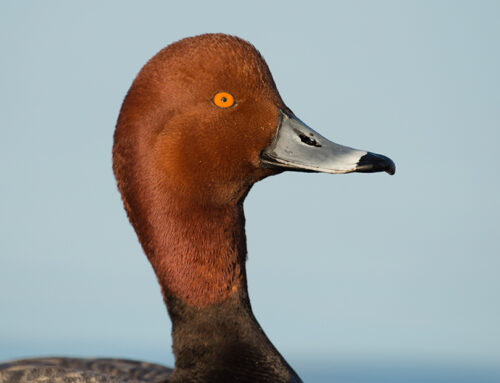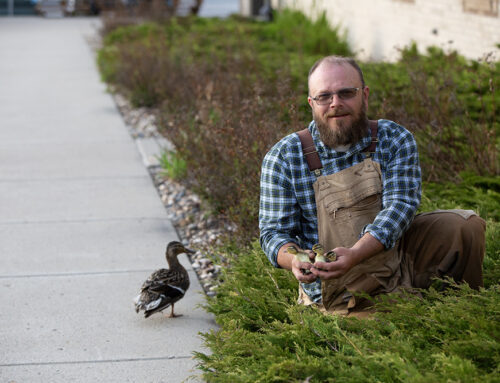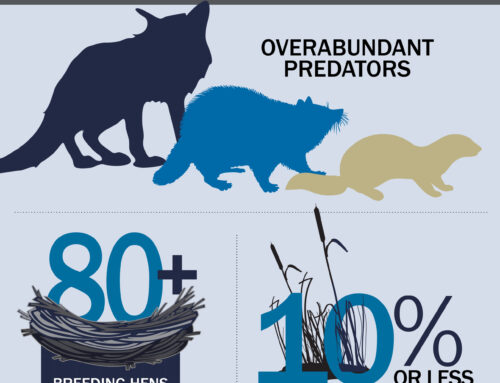Waterfowl in Winter
Unique adaptations allow ducks to thrive in frigid conditions

As winter’s approach brings frigid winds, bleak temperatures, and dwindling food resources, ducks do whatever it takes to survive the cruelest conditions. In fact, while most ducks head south in search of open water and a better selection of food resources, some odd ducks have found success with an unlikely strategy: Their migration takes a lateral or even northward route.
Regardless of their wintering tactics, all ducks’ biology is wired to adapt to the environmental conditions around them, and the additional processes that help them survive are thoroughly fascinating.

Ducks rely on feathery insulation and, if necessary, slowed metabolisms to endure winter.
North for Winter?
Certain eiders, notably the spectacled eider, are sometimes known to travel a lateral or northward migration route for the winter. Moving throughout the Arctic from the breeding grounds to their wintering residences, they spend January and February hunkered down in holes in the pack ice. Surviving in an unpleasant combination (at least from the human perspective) of darkness and extreme cold, these particular species thrive in conditions few other ducks could tolerate.
Of course, the majority of ducks journey southward come fall to conditions in which they can also thrive, using variations of the following processes to sustain themselves until spring.
Slowed Metabolism
Throughout the winter months, food acquisition can be tough in the most extreme wintering periods, so conserving energy emerges as a top priority. Yet, ducks have the ability to wait out the worst of storms: Their body allows their metabolic rate to drop, they adjust for the fact that they will not have access to nutrients, and in turn they sustain energy.
“There have been studies where they held some black ducks captive and got interesting results,” said Dr. Chris Nicolai, Delta’s waterfowl scientist. “In one particular study, there were two groups—one to which the researchers fed heavy amounts of food, and another in which they withheld food. Interestingly, the birds adjusted and stayed the same. So, even though some ducks ate tons of food, they burned that excess energy. Whereas if they didn’t have a ton of food, they held their reserves tight and rode through it without issues.”
These grueling conditions force ducks into “lazy mode.” Specifically, they learn to adjust their metabolism to adverse environmental conditions by sitting tight and conserving energy, especially when the temperatures hit brutal lows.
Frost-fighting Feathers
When riding out frigid weather, insulation matters most. By the time fall transforms into winter, a duck’s feathers have finished growing, they’re in optimal condition, and ducks spend their months enveloped in a warm, feathery coat. To keep their insulation dry (which occurs year-round), preening oil is secreted from a gland at the base of the ducks’ tails. They distribute it with their bills while preening, creating an initial barrier of water-repellant protection, safeguarding their skin from icy water, and improving the processes that regulate temperature and retain body heat.
“When the temperature drops, they also have other systems in place,” Dr. Nicolai said. “Ducks will get their big, huge contour feathers to stand up as high as they can—kind of like a person getting goosebumps—which really allows the down beneath to expand and hold all the air that they are warming up with their body temperature. Then, they just snuggle their skin-covered bill into that, and they’re living pretty large even though it might be brutal out there.”
Counter-current Heat Exchange
Coming into contact with icy external environments can wreak havoc on heat conservation. Cue counter-current heat exchange. Rather than circulating blood throughout their whole bodies, ducks isolate the blood that flows in their legs. This process plays a crucial role in the efficiency in which they are able to conserve heat, and also explains why they can walk on very cold ice without developing frostbite.
“A duck’s artery and its vein touch each other in the tarsus—the leg bone above the joints of the foot extending to where their feathers begin,” said Dr. Nicolai. “As the warm blood exits the body, it rewarms the cold blood (cooled by contact with ice and other external conditions) that is coming back into the body from the leg. The duck’s webbed foot can easily deal with the cold, but this keeps the duck from shocking its body with cold temperatures from the return flow of blood.”
The smaller the temperature difference between two objects (e.g., a duck’s foot and a frozen pond), the more slowly heat will be exchanged.
In a duck’s case, as arterial blood supplies its warmth to the venous blood, it somewhat cools the blood flowing into the feet. The feet are supplied with the perfect amount of blood and produce just the right amount of warmth to avoid frostbite. So, lessening the temperature difference between a duck’s foot and the ice minimizes the amount of heat lost—a critical energy conserver when temperatures drop.

Winter Wonders
There are aspects of wintering waterfowl that remain mysterious.
“Something what really interests me are identical or similar species that winter in different latitudes,” said Dr. Nicolai. “Black brant, for example, all historically went to Mexico, but now almost half of them stay in Alaska. So, instead of flying 3,500 miles each way for winter, they’ve adjusted. They’re staying in the dark and eating better, more nutrient-rich food. Research was done when multiple brant were shot at different latitudes, some up north and others farther south. When they were compared, it was found that they had used completely different strategies to survive.”
In Nicolai’s example, body lipids (fats) decreased for brant wintering in Alaska but increased for the Baja California birds. Conversely, body protein increased over winter for the Alaska brant and remained stable for the Baja California flock.
“As hunters and scientists, we wonder: They stayed in different wintering habitats, but how did that ultimately impact them during breeding?” asked Dr. Nicolai. “For the most part, you don’t find a lot of differences. Somehow, they are making these different strategies work the same for them. They are tough birds with a bunch of different strategies.”
Survive and Thrive
So, the next time a cruel storm sweeps through, know that ducks are hunkered down and adapting. Their bodies are deploying a multitude of neat strategies that help them do what they do best—whether they went north to south, or south to north.
Christy Sweigart of Elizabeth, Colorado, is a staff writer for Delta Waterfowl.






Leave A Comment